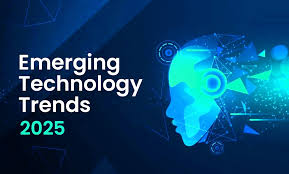Introduction To Emerging Technologies
Imagine this: You’re driving an electric car in 2025 that isn’t just battery-powered; the battery is the vehicle itself. There are no heavy packs to drag you down; instead, it has a sleek, practical design that looks like it belongs in a science fiction movie. Or picture taking a pill that contains bacteria that have been engineered to fight disease from the inside out, like little superheroes in your stomach. Sounds crazy, doesn’t it? However, these aren’t just wishful thinking; they’re a part of the new technologies that are sweeping the market this year.
Consider this: In 2025, the electric car you’re driving isn’t merely battery-powered; it’s the battery itself. It has a sleek, useful design that looks like it belongs in a science fiction film, and there are no bulky packs to pull you down. Or imagine taking a pill that contains bacteria, like tiny superheroes in your stomach, that have been designed to fight disease from the inside out. Don’t you think that sounds crazy? These, however, are not merely idealistic thoughts; rather, they are a component of the new technologies that are dominating the market this year.
We’ll examine the top ten emerging technologies you need to be aware of in this post, fusing cutting-edge analysis with a hint of humor (because who says technology can’t be entertaining?). Prepare to geek out on everything from AI that detects fakes to sustainable energy hacks. Let’s get started; your future self will appreciate it.
The Rise of Emerging Technologies
Let’s talk about why emerging technologies are important in 2025 before we dive into the list. These are cutting-edge technological trends that are pushing the limits of sustainability, health, and connectivity; they are not your grandmother’s flip phones. Future technologies like these could solve real-world problems and boost the global economy by trillions, with biotech and artificial intelligence at the forefront. Are you curious about previous hits? For background, see our guide to 2024 tech innovations.

Why 2025 Is a Pivotal Year
Integration is the key to 2025 tech trends: fusing energy and the environment, biology and machines. According to experts, advances in cutting-edge innovations will propel a 25% increase in adoption rates.
1. Structural Battery Composites
Consider how much lighter, more durable, and much less cumbersome it would be if the case of your smartphone also served as its battery. Structural battery composites, one of the most exciting new technologies for 2025, work like that. Electric vehicles (EVs) and airplanes are being revolutionized by these weight-bearing materials that store electrical energy directly in their structure.
How does it operate? In order to create composites that are both robust and energy-dense, engineers weave carbon fibers with electrolytes. Efficiency won’t be hampered by separate batteries anymore! This could reduce hundreds of pounds and increase range in EVs by as much as 70%. Think of how amazing it would be to travel from New York to Los Angeles on a single charge.
But hold on, the obstacles have a humorous side: In the event of an earthquake, early prototypes were about as stable as a Jenga tower. They are now safer and more scalable thanks to developments from labs like Chalmers University. Effects? Great for the environment—lighter aircraft use less fuel, which reduces emissions. Check out our post on sustainable energy tips if you’re interested in green technology.
Key benefits in a table:
| Benefit | Description |
|---|---|
| Weight Reduction | Up to 50% lighter than traditional batteries |
| Applications | EVs, drones, wearables |
| Environmental Impact | Reduces carbon footprint by 30% |
2. Osmotic Power Systems
Have you ever combined fresh and salt water and exclaimed, “Hey, that’s energy!”? Osmotic power systems, on the other hand, use the pressure created by water passing through membranes to produce clean electricity. In terms of emerging technologies, this one is a cunning genius because it is low-impact, renewable, and ideal for coastal regions.
The technology generates power through processes like Pressure Retarded Osmosis (PRO), which uses gradients of salt. It was invented by Statkraft in Norway, but by 2025, larger versions will be supplying electricity to whole communities. The irony is that it functions similarly to nature’s own battery without the risk of blowing up (look at you, lithium-ion).
Effects? It could supply 200 million homes with 2,000 TWh per year worldwide. We’re talking energy independence when we combine it with cutting-edge renewable technology. Visit our overview of renewable sources to learn more about clean energy.
Read more: Top 10 Emerging Technologies of 2025 (According to Science)
3. Advanced Nuclear Technologies
Because of Chernobyl reruns, nuclear power has a bad reputation, but in 2025, cutting-edge nuclear technologies are changing that. Consider more affordable, fusion-ready, and safer small modular reactors (SMRs). The goal of these cutting-edge technologies is limitless clean energy without the drama of a meltdown.
SMRs use coolants like molten salt, are portable, and are manufactured in a factory. Through initiatives like ITER, Fusion, the holy grail, simulates the sun. Joke alert: Fusion is similar to atomic matchmaking—tricky but rewarding—if fission is the splitting of atoms.
worldwide effect? could sustainably power AI data centers while reducing energy expenses by 30%. Explore our article on nuclear energy myths busted in more detail.
4. Engineered Living Therapeutics
What if your body had little factories that produced medication whenever you needed it? One of the most astounding new technologies is engineered living therapeutics, which transform microorganisms into drug-delivery experts. They treat illnesses from the inside out by altering the DNA of bacteria.
Probiotics’ ability to combat cancer and digestive disorders is one of 2025’s highlights. It’s heroic but hilarious, like giving your microbiome a doctorate in pharmacy. Difficulties? preventing them from going rogue, but trials indicate promise.
Impacts: Millions of people will benefit from less expensive chronic illness treatments. Connected? Our guide to biotechnology fundamentals.
5. GLP-1s for Neurodegenerative Disease
GLP-1s began as weight-loss miracles (hey, Ozempic), but by 2025, they are cutting-edge treatments for Parkinson’s and Alzheimer’s diseases. These medications essentially perform a brain detox by lowering inflammation in the brain and eliminating harmful proteins.
Funny side: Did you know that medications for diabetes could also save neurons? Studies reveal a 20–30% decrease in symptoms. This means healthier golden years for people of all ages.
6. Autonomous Biochemical Sensing
Real-time wearables that can read the chemistry of your body? With autonomous biochemical sensing, you can wirelessly detect hormones or glucose, much like a lab on your wrist. Here, cutting-edge technologies simplify the management of diabetes.
The 2025 versions run on their own and last for several months. Imagine being both annoyed and saved by your watch alerting you to low electrolytes!

7. Green Nitrogen Fixation
Fertilizers consume energy while feeding the world. One of the eco-hero emerging technologies of 2025 is green nitrogen fixation, which produces ammonia sustainably using bacteria and green energy.
It’s like tampering with the natural process of plants to reduce emissions by 90%. Joke: Microbes may soon be more appreciated by farmers than the rain gods.
8. Nanozymes
Synthetic enzymes, or nanozymes, are more resilient and less expensive than natural ones. These new technologies catalyze reactions to treat cancer or purify water.
They zap pollutants like superheroes, according to 2025 trials. Amusing: Enzymes without the anger.
versatile in terms of the environment and health.
Read more: 10 Key Breakthrough Technologies of 2025
9. Collaborative Sensing
Sensors talking to each other? Collaborative sensing networks traffic lights with cameras for smarter cities. Emerging technologies reducing congestion and pollution.
2025: Mines, storms, all monitored seamlessly. Like a sensor symphony—harmonious and efficient.
10. Generative Watermarking
Generative watermarking identifies fakes in a deepfake world by tagging AI content. emerging technologies that are essential to media trust.
Challenges: They are being stripped by hackers, but their adoption is increasing. Watermarks that say, “I’m not real, but I’m honest!” is humorous.
Conclusion
What a journey through 2025’s top ten emerging technologies! These innovations combine cutting-edge technology with workable solutions, from structural batteries that lighten our loads to watermarking that keeps us real. They will address climate issues, improve health, and boost economies, which could add up to $100 trillion by 2030. Keeping up with 2025 tech trends will enable you to adapt and prosper, regardless of your age.
Are you prepared to get even more geeky? What new technology most excites you? Tell us in the comments below. Participate in the discussion, share, and subscribe!
Read more: 7 Shocking AI Tools That Can Replace Your Job in 2025
FAQs
What are the top emerging technologies in 2025?
The World Economic Forum lists structural battery composites, osmotic power, and more as key emerging technologies. They focus on sustainability and health, with potential to transform industries globally in the coming years.
How do emerging technologies impact daily life?
Emerging technologies like autonomous sensing make health monitoring effortless, while green fixes reduce food costs. They enhance convenience, cut emissions, and create jobs, affecting everyone from kids using AI tools to seniors benefiting from better meds.
Are emerging technologies safe for the environment?
Many 2025 emerging technologies prioritize eco-friendliness, like osmotic power generating clean energy. However, oversight is key to minimize risks, ensuring innovations like nanozymes don’t harm ecosystems while solving pollution issues.
What careers will emerging technologies create?
Tech trends 2025 will boom jobs in AI ethics, biotech engineering, and renewable energy. Skills in cutting-edge innovations like collaborative sensing could lead to roles paying over $100K, appealing to all age groups entering the workforce.
How can I invest in emerging technologies?
Start with stocks in companies pioneering breakthrough technologies, like those in advanced nuclear. Research ETFs focused on innovative tech but consult experts—2025’s volatility means smart, diversified bets for long-term gains.

